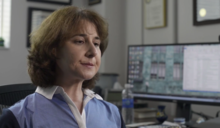Susan Buthaina Sinnott is professor and head of materials science and engineering at Pennsylvania State University.[1][2] Sinnott is a fellow of the Materials Research Society (MRS), the American Association for the Advancement of Science (AAAS) and the American Physical Society (APS). She has served as editor-in-chief of the journal Computational Materials Science since 2014.
Early life and education
Sinnott received a bachelors of science in chemistry at the University of Texas at Austin.[3][4] She moved to Iowa State University for her graduate studies, and earned her doctoral degree in physical chemistry in 1993.[3]
Research and career
After graduating Sinnott moved to the United States Naval Research Laboratory where she worked on surface chemistry.[3][5]

After two years at the Naval Research Laboratory, Sinnott was appointed an assistant professor at the University of Kentucky.[7] In 2000 she was recruited to the University of Florida as an Associate Professor.[3] Sinnott was promoted to Professor at the University of Florida in 2005, where she led projects on cyber infrastructure and quantum theory.[3] In 2015 Sinnott was appointed Head of Materials Science and Engineering at the Pennsylvania State University.[3][8][9]
Sinnott's research involves the development of computational methods to understand the electronic and atomic structure of materials.[1] Her computational models include continuum level modelling and fluid dynamics and take into account material behaviour at the nanoscale.[7] She has investigated the formation and role of grain boundaries, dopants, defects and heterogeneous interfaces.[10][11] Her research has considered perovskites, showing that the alignment or tilting of the perovskite oxygen cages impacts the materials properties.[12] Sinnott has served as editor-in-chief of the scientific journal Computational Materials Science since 2014.[10]
Her principal research interests at Penn State University include two-dimensional and nano-structured materials, gas adsorption and separation in porous solid materials, and condensed matter physics.[13]
Selected awards and honours
Her awards include:
- 2005 Elected a fellow of the American Vacuum Society[14]
- 2009 Distinguished editor of the Physical Review Letters[15]
- 2010 Elected a fellow of the American Association for the Advancement of Science[16][17]
- 2011 Elected a fellow of the American Ceramic Society[14]
- 2012 Elected a fellow of the Materials Research Society[18]
- 2013 Elected a fellow of the American Physical Society[19]
- 2013 Top 25 Women Professors in Florida[20]
Selected publications
Her publications[1][2] include
- A second-generation reactive empirical bond order (REBO) potential energy expression for hydrocarbons[21]
- Model of carbon nanotube growth through chemical vapor deposition[22]
- Carbon nanotubes: synthesis, properties, and applications[23]
- Effect of chemical functionalization on the mechanical properties of carbon nanotubes[24]
References
- ^ a b c d Susan Sinnott publications indexed by Google Scholar
- ^ a b Susan Sinnott publications from Europe PubMed Central
- ^ a b c d e f "Susan Sinnott — Penn State University - Department of Chemistry". chem.psu.edu. Retrieved 2020-03-05.
- ^ "nanoHUB.org - Members: View: Susan Sinnott". nanohub.org. Retrieved 2020-03-05.
- ^ "SUSAN B Sinnott". ornl.gov. Oak Ridge National Laboratory. Retrieved 2020-03-05.
- ^ Benefunder (2015-06-09), Using Computers to Create New Materials, retrieved 2020-03-06
- ^ a b "Susan Sinnott". Penn State Department of Materials Science and Engineering. 2018-02-16. Retrieved 2020-03-05.
- ^ "Dr. Susan Sinnott". mse.vt.edu. Retrieved 2020-03-05.
- ^ "Sinnott appointed head of materials science and engineering | Penn State University". news.psu.edu. Retrieved 2020-03-05.
- ^ a b "Susan Sinnott". journals.elsevier.com. Retrieved 2020-03-05.
- ^ "Interviews with plenary speakers of the XV Brazil-MRS Meeting: Susan Sinnott (Penn State, USA). – SBPMat – Sociedade Brasileira de Pesquisa em Materiais". Retrieved 2020-03-05.
- ^ "A 3D imaging technique unlocks properties of perovskite crystals". news.psu.edu. Penn State University. Retrieved 2020-03-05.
- ^ "Sinnott Research Group |". research.matse.psu.edu. Retrieved 2021-10-17.
- ^ a b Madsen, Lynnette (2016-02-01). Successful Women Ceramic and Glass Scientists and Engineers: 100 Inspirational Profiles. John Wiley & Sons. ISBN 978-1-118-73360-8.
- ^ "Physical Review Journals - Outstanding Referees". journals.aps.org. Retrieved 2020-03-05.
- ^ "Three UF researchers named AAAS Fellows - News - University of Florida". news.ufl.edu. Retrieved 2020-03-05.
- ^ "AAAS Members Elected as Fellows". American Association for the Advancement of Science. Retrieved 2020-03-05.
- ^ "Dr. Cammy Abernathy has been recognized as a 2015 Fellow of the Materials Research Society (MRS) – Department of Materials Science and Engineering". Retrieved 2020-03-05.
- ^ "Susan Sinnott elected APS Fellow – Department of Materials Science and Engineering". Retrieved 2020-03-05.
- ^ "Professor Susan Sinnott selected as one of the Top 25 Women Professors in the state of Florida – Department of Materials Science and Engineering". mse.ufl.edu. Retrieved 2020-03-05.
- ^ Brenner, Donald W; Shenderova, Olga A; Harrison, Judith A; Stuart, Steven J; Ni, Boris; Sinnott, Susan B (2002). "A second-generation reactive empirical bond order (REBO) potential energy expression for hydrocarbons". Journal of Physics: Condensed Matter. 14 (4): 783–802. Bibcode:2002JPCM...14..783B. doi:10.1088/0953-8984/14/4/312. ISSN 0953-8984. S2CID 11755258.
- ^ Sinnott, S.B.; Andrews, R.; Qian, D.; Rao, A.M.; Mao, Z.; Dickey, E.C.; Derbyshire, F. (1999). "Model of carbon nanotube growth through chemical vapor deposition". Chemical Physics Letters. 315 (1–2): 25–30. Bibcode:1999CPL...315...25S. doi:10.1016/S0009-2614(99)01216-6. ISSN 0009-2614.
- ^ "Filled Carbon Nanotubes", Carbon Meta-Nanotubes, John Wiley & Sons, Ltd, 2011-10-31, p. 223, doi:10.1002/9781119954743.ch5, ISBN 978-1-119-95474-3
- ^ Garg, Ajay; Sinnott, Susan B. (1998). "Effect of chemical functionalization on the mechanical properties of carbon nanotubes". Chemical Physics Letters. 295 (4): 273–278. Bibcode:1998CPL...295..273G. doi:10.1016/S0009-2614(98)00969-5. ISSN 0009-2614.


Recent Comments